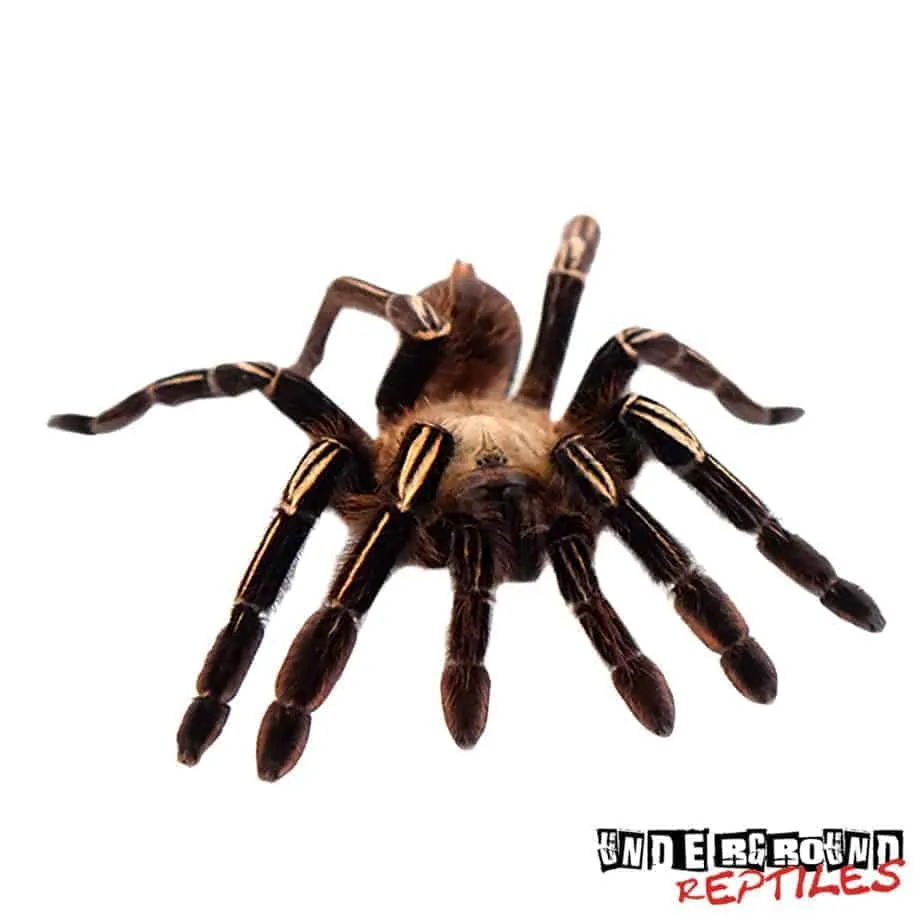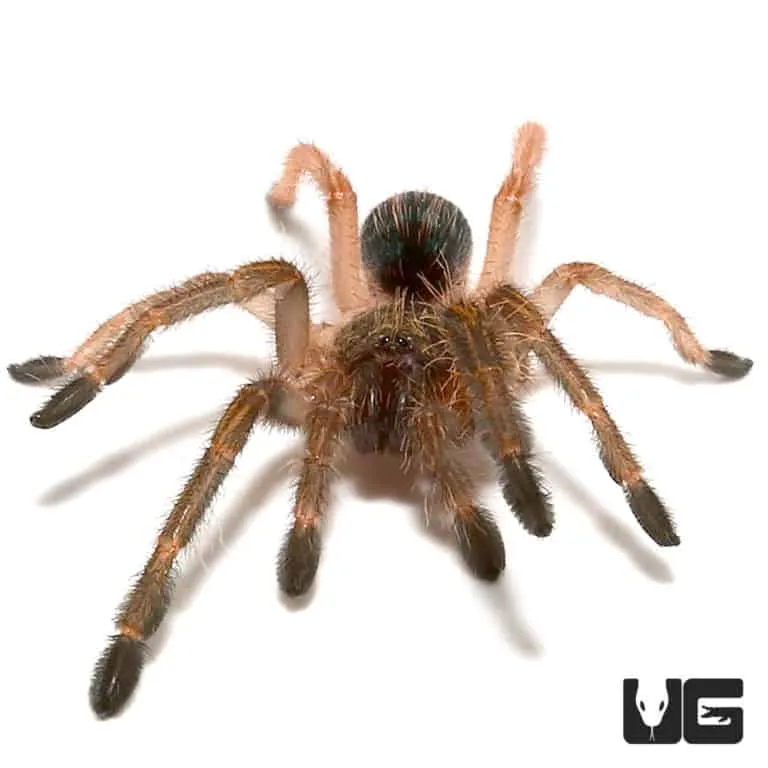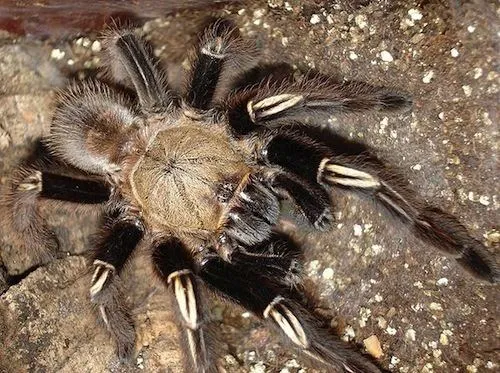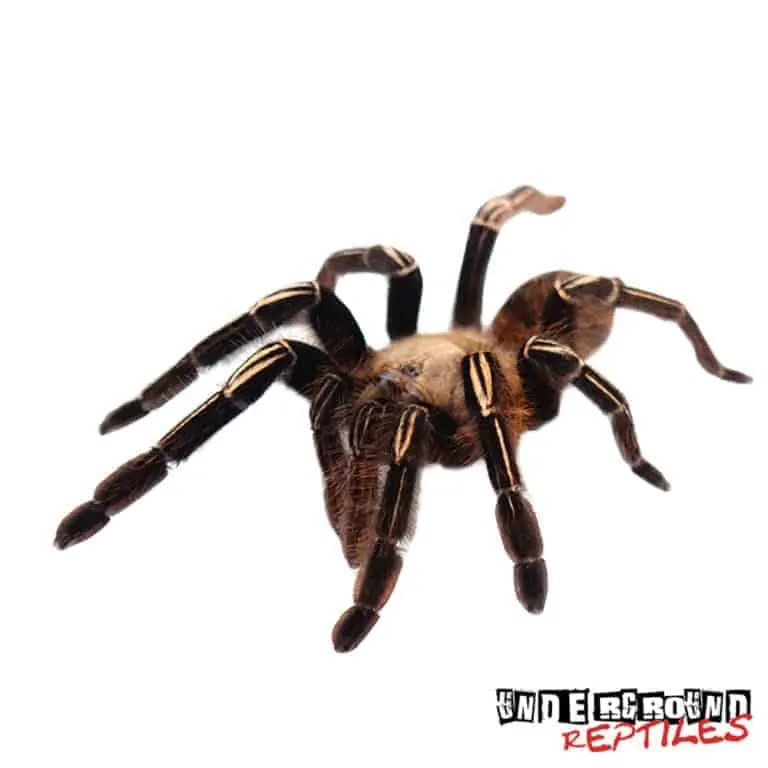What is a Skeleton Tarantula
The Skeleton Tarantula, scientifically known as Ephebopus murinus, is a captivating and unique arachnid that has become increasingly popular among exotic pet enthusiasts. Its common name is derived from the striking pattern on its legs, which resembles a skeleton, providing a fascinating visual appeal. This tarantula is native to the rainforests of Brazil, French Guiana, and Suriname. Its popularity stems not only from its distinctive appearance but also from the relatively manageable care requirements that make it a captivating addition to any tarantula collection. If you’re considering bringing one of these fascinating creatures into your home, this comprehensive guide provides everything you need to know about buying a Skeleton Tarantula, ensuring a healthy and enriching experience for both you and your new pet.
Appearance and Characteristics
The Skeleton Tarantula is known for its distinctive appearance, which is the primary reason for its captivating name. The legs of this tarantula showcase a striking pattern of white or cream-colored stripes against a dark background, closely resembling a skeleton. The body of the tarantula is typically a dark brown or black color, providing a strong contrast with the leg markings. Adult females can reach a leg span of up to 5-6 inches, while males are generally slightly smaller. They possess a moderate-sized body with a robust build, and they are covered in fine hairs, giving them a slightly velvety texture. This species is a fast-growing tarantula, reaching maturity within a few years under the right conditions.
Origin and Habitat

Skeleton Tarantulas are native to the tropical rainforests of South America, specifically regions of Brazil, French Guiana, and Suriname. In their natural habitat, they are terrestrial spiders, meaning they live on the ground rather than in trees. They are known to create burrows or utilize natural shelters such as fallen logs or leaf litter to hide from predators and regulate their environment. The climate in these regions is typically warm and humid, which is crucial for their survival. When replicating the habitat in captivity, it’s essential to mimic these conditions to ensure the health and well-being of your Skeleton Tarantula. This includes maintaining a specific temperature range, providing adequate humidity, and offering a suitable substrate that allows burrowing.
Where to Buy a Skeleton Tarantula
If you’re looking to buy a Skeleton Tarantula, there are a few reliable avenues. The most common and potentially safest way to buy is from reputable breeders or specialized exotic pet stores. These sources typically have a good understanding of tarantula care and can provide healthy specimens. Additionally, online marketplaces can be a source, but it’s crucial to vet sellers carefully by checking reviews and ensuring they can provide proper shipping protocols. Local pet stores that specialize in exotic animals might sometimes carry Skeleton Tarantulas, offering the advantage of in-person inspection before purchase. Always prioritize the tarantula’s health and the seller’s reputation.
Finding Reputable Breeders
Finding a reputable breeder is essential for the health of your Skeleton Tarantula. Look for breeders who prioritize the well-being of their tarantulas and have experience in the species. Check for reviews or testimonials from other buyers to assess the breeder’s reliability and the health of their tarantulas. A good breeder will be knowledgeable, able to answer your questions about care, and willing to provide information on the tarantula’s origin. Avoid breeders who seem evasive or unwilling to share details about their tarantulas. Moreover, consider the breeder’s shipping practices; reputable breeders will take precautions to ensure the tarantula arrives safely and stress-free. Choosing a reputable breeder is a crucial first step towards a healthy and thriving Skeleton Tarantula.
Online vs Local Pet Stores

Both online sources and local pet stores offer different pros and cons when you are looking to buy a Skeleton Tarantula. Online retailers often provide a wider selection and may offer competitive prices, however, you can’t see the tarantula in person before purchasing. The shipping process, while usually safe, does introduce an element of stress for the spider. Local pet stores allow for immediate inspection of the tarantula, which can provide peace of mind. They can also offer on-the-spot advice and support. However, local stores might have a limited selection and higher prices. Consider factors like the store’s reputation, return policies, and their staff’s expertise before making a decision. Evaluate which option offers the best balance of selection, cost, and assurance of the tarantula’s health based on your preferences.
Factors to Consider Before Buying
Before you buy a Skeleton Tarantula, it’s essential to consider several factors to ensure you can provide the proper care. Assess your commitment to the long-term care of the tarantula, as they can live for many years. Research the specific care requirements of the Skeleton Tarantula, including its habitat, diet, and temperature needs. Make sure you can provide a suitable enclosure with appropriate substrate, temperature, and humidity levels. Consider the potential costs associated with the tarantula, including the initial purchase price, the cost of the enclosure, substrate, food, and any necessary equipment. Finally, make sure that you and everyone in your household are comfortable with the idea of living with a tarantula; ensure there are no allergies or aversions that might impact your ability to care for the spider.
Pricing and Cost
The price of a Skeleton Tarantula can vary depending on several factors, including the size, age, and the breeder. Typically, the price can range from $30 to $100 or more for juveniles, with adult females often costing more due to their longer lifespans and breeding potential. In addition to the initial purchase price, you must factor in ongoing costs such as the enclosure, substrate, food (crickets, roaches), and any necessary equipment like heat lamps or humidity gauges. Regular expenses include the purchase of new substrate, replacement of food items, and possibly vet visits if your tarantula requires medical attention. Before buying, create a budget that includes the purchase price and ongoing expenses to ensure you can provide proper care without financial strain. Overall, the total cost varies based on the individual tarantula and the level of care you choose to provide.
Health and Temperament

Skeleton Tarantulas are known for their generally docile temperament, which makes them relatively easy to handle compared to some other tarantula species. However, it’s important to note that each tarantula has its personality, and some may be more skittish or defensive than others. While they are not generally aggressive, they can bite if provoked, and their bite can be painful, though not usually medically significant to humans. As for their health, Skeleton Tarantulas are generally hardy. Signs of a healthy tarantula include an active appetite, a plump abdomen, and normal movement. Look for any signs of illness, like lethargy, loss of appetite, or unusual behavior. Quarantine new tarantulas to monitor them for any signs of illness before introducing them to other spiders you may have.
Setting Up a Habitat
Setting up the correct habitat is one of the most critical factors in successfully keeping a Skeleton Tarantula. Creating an environment that mimics its natural habitat is crucial for its health and well-being. This involves providing a suitable enclosure, appropriate substrate, and maintaining the right temperature and humidity levels. Properly setting up the enclosure ensures that the tarantula can thrive, eat properly, and exhibit natural behaviors. The right habitat will also reduce stress and help your tarantula feel safe, thus leading to a longer, healthier life. Always prioritize the comfort and safety of your tarantula by carefully planning and setting up its enclosure.
Enclosure Size and Type
The enclosure should be appropriately sized for the tarantula. A juvenile Skeleton Tarantula can thrive in a smaller enclosure, such as a 5-10 gallon tank, while adults require a larger space to move around. A 10-20 gallon tank is suitable for an adult, with more horizontal space being preferable, as they are terrestrial. The enclosure should be escape-proof; a secure lid is essential to prevent the tarantula from escaping. Ventilation is also crucial; ensure the enclosure has proper airflow to prevent mold and maintain humidity levels. Glass or acrylic tanks are common choices, with acrylic offering the benefit of being lighter and less prone to breakage. Choose an enclosure that’s easy to clean, offers good visibility, and can maintain the appropriate temperature and humidity.
Substrate and Decor

The substrate is a vital part of the tarantula’s enclosure, as it allows the spider to burrow and provides a comfortable environment. A suitable substrate should retain moisture, be non-toxic, and allow the tarantula to burrow. A mixture of peat moss, coco fiber, and vermiculite is a popular choice, providing excellent moisture retention and burrowing capabilities. Avoid using substrates that can be harmful, such as cedar or pine shavings. Add decorations, such as cork bark, artificial plants, or hides, to create a natural and enriching environment for the tarantula. These decorations provide security, allowing the tarantula to feel safe and reduce stress. Make sure to arrange the decor in a way that does not limit the tarantula’s movement. Ensure the enclosure is free of any toxic materials that could harm your tarantula.
Temperature and Humidity
Maintaining the correct temperature and humidity levels is essential for the health of your Skeleton Tarantula. The ideal temperature range is between 75°F to 85°F (24°C to 29°C). Use a heat lamp or a heat mat attached to the side of the enclosure, never under it, to maintain the temperature. Ensure the heat source is regulated with a thermostat to prevent overheating. Skeleton Tarantulas also need a humidity level between 70% to 80%. You can monitor the humidity levels using a hygrometer. To maintain humidity, lightly mist the enclosure with water a few times a week or provide a shallow water dish that will allow the humidity to rise. Make necessary adjustments to these elements as needed to provide a comfortable environment for your tarantula.
Feeding and Care
Proper feeding and care are essential for the health and longevity of your Skeleton Tarantula. This involves providing a balanced diet, a regular feeding schedule, and ensuring access to fresh water. Proper nutrition will help the tarantula grow and thrive while maintaining its health. Furthermore, it’s essential to recognize the natural habits of Skeleton Tarantulas, and to avoid unnecessarily disturbing or stressing them.
Diet and Feeding Schedule

Skeleton Tarantulas are carnivorous, and their diet primarily consists of insects. Crickets and cockroaches are excellent choices and readily available at most pet stores. Feed juvenile tarantulas about twice a week, and adults can be fed once a week or every other week, depending on their size and appetite. The insects should be appropriately sized for the tarantula; the prey should not be larger than the tarantula’s body. Always remove uneaten prey within 24 hours to prevent them from stressing the tarantula. You can also supplement their diet with other insects, such as mealworms or waxworms, but these should be given sparingly. The key is to provide a varied and balanced diet.
Water and Hydration
Providing access to fresh water is critical for the Skeleton Tarantula’s hydration. A shallow water dish should always be available in the enclosure. This dish should be filled with clean water and replaced regularly, typically a few times a week. Use a small dish, such as a bottle cap or a shallow dish designed specifically for tarantulas, to prevent the tarantula from drowning. In addition to the water dish, you can mist the enclosure lightly with water a few times a week to maintain humidity. This helps the tarantula with hydration. Proper hydration is essential for its molting process and overall health. Always ensure the water dish is accessible and clean and that the tarantula has adequate moisture in the environment.
Common Health Issues
While Skeleton Tarantulas are generally hardy, they are susceptible to some health issues. Common health problems include dehydration, which can be prevented by providing access to fresh water and maintaining proper humidity levels. Parasites can be a concern, so it’s important to quarantine any new tarantulas and monitor for any signs of infestation. Injuries can occur if the tarantula falls from a height or is mishandled. Symptoms of illness to watch for include lethargy, loss of appetite, or unusual behavior. If you notice any signs of illness, consult a veterinarian specializing in exotic animals. Regular observation and proper care will minimize the risk of health issues and promote a long, healthy life for your Skeleton Tarantula.
Molting Process

Molting is a natural and essential process for Skeleton Tarantulas, where they shed their exoskeleton to grow. This process is crucial for their growth and development. Before molting, the tarantula may become less active, refuse food, and spend more time hiding. The tarantula will usually flip on its back during the molting process. It is essential not to disturb the tarantula during this time. Provide a humid environment and avoid handling the tarantula, as it will be vulnerable during and after molting. The molting process can take several hours, or even days, depending on the tarantula’s size and age. After molting, the tarantula’s new exoskeleton will be soft; it will take a few days to harden. Do not feed the tarantula until its fangs have fully hardened. Molting is a sign of a healthy, growing tarantula.
Shedding and Care
After the molting process, it’s important to properly care for your Skeleton Tarantula. Do not disturb the tarantula until its new exoskeleton hardens, which can take a few days to a week. After the exoskeleton hardens, offer the tarantula food. You can feed the tarantula more frequently, as it may be hungry after the process. Remove the old exoskeleton from the enclosure; this is a good way to check the health of your tarantula. After a successful molt, the tarantula will appear brighter and more vibrant. During molting, it’s important to maintain the right humidity level to assist the molting process and ensure the tarantula’s safety.
Handling and Interaction
While Skeleton Tarantulas are known for their docile nature, handling should be approached with care and caution. It is generally recommended to avoid handling them, as tarantulas are easily stressed, and unnecessary handling can increase the risk of injury to the tarantula or the handler. If you choose to handle your Skeleton Tarantula, do so only when necessary and with extreme care. Avoid sudden movements, and ensure you are handling the tarantula over a soft surface in case it falls. Never grab or squeeze the tarantula; instead, allow it to walk onto your hand. Be aware of the tarantula’s behavior. If the tarantula appears agitated or defensive, it’s best to leave it alone. Remember that handling can be stressful for the tarantula, and the risk of a bite is always present.
Tarantula’s Behavior

Understanding your Skeleton Tarantula’s behavior is crucial for providing proper care. Skeleton Tarantulas are generally reclusive and spend most of their time in their burrows or hiding places. They are nocturnal, and most of their activity occurs during the evening or nighttime. Observe your tarantula’s behavior regularly to identify any changes. A healthy tarantula will typically have a good appetite and move around the enclosure without any difficulty. Look for signs of stress, such as pacing, refusal to eat, or excessive hiding. Understanding and observing tarantula’s behavior will provide valuable insights into its health and well-being.
Safe Handling Practices
If handling is unavoidable, use safe handling practices to protect both you and your Skeleton Tarantula. Always wash your hands thoroughly before and after handling your tarantula to prevent the spread of bacteria. Handle the tarantula over a soft surface, like a bed or a low table, to prevent injury in case of a fall. Allow the tarantula to walk onto your hand; never grab or squeeze it. Avoid any sudden movements, as they can startle the tarantula. Be aware of the tarantula’s behavior, and if it appears agitated, place it back in its enclosure immediately. Always supervise children when they are near the tarantula and educate them about the proper way to interact with it. Prioritize safety and the tarantula’s well-being by following these handling guidelines.
Long-Term Care and Maintenance
Long-term care and maintenance are essential for ensuring your Skeleton Tarantula lives a healthy, long life. This involves regular cleaning, monitoring the enclosure, and providing ongoing observation. Consistent attention to these aspects will provide the best possible environment for the spider. By practicing proper maintenance, you ensure your tarantula’s well-being and a rewarding experience for you as a pet owner.
Regular Cleaning
Regular cleaning is an essential part of Skeleton Tarantula care. Spot clean the enclosure regularly to remove any uneaten food, shed exoskeletons, or feces. This will prevent the buildup of bacteria and maintain the cleanliness of the enclosure. It is also important to change the substrate every few months, or more frequently if it becomes soiled or starts to smell. During cleaning, be sure to handle the tarantula with extreme care, if necessary, or let it stay in a temporary container. Clean the enclosure with a mild soap and water solution and rinse thoroughly. Always ensure the enclosure is completely dry before placing the tarantula back inside. Regular cleaning is important for promoting a healthy and comfortable environment.
Monitoring and Observation
Regular monitoring and observation are critical for maintaining the health and well-being of your Skeleton Tarantula. Observe your tarantula’s behavior, appetite, and overall appearance regularly. Look for any signs of illness, such as lethargy, loss of appetite, or unusual behavior. Monitor the temperature and humidity levels in the enclosure daily to ensure they are within the appropriate range. Check the water dish to ensure it is clean and filled. By observing your tarantula and its environment regularly, you can identify any issues early on and take corrective action. Monitoring and observation will help keep your Skeleton Tarantula healthy and thriving.
Bringing a Skeleton Tarantula into your home is a rewarding experience for those fascinated by exotic pets. By following the guidelines in this comprehensive guide, you will be well-equipped to care for your Skeleton Tarantula, ensuring it lives a long and healthy life. From choosing the right tarantula to setting up the perfect habitat, feeding, and handling with care, this guide covers all the essentials. Remember that consistent care, proper research, and a commitment to providing the best possible environment will allow you to enjoy the unique beauty and fascinating behaviors of your Skeleton Tarantula for years to come.
